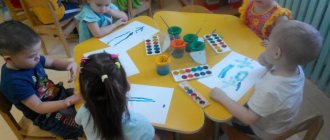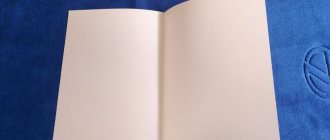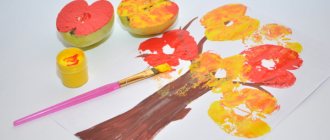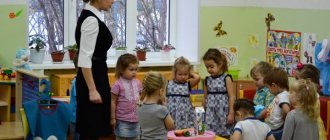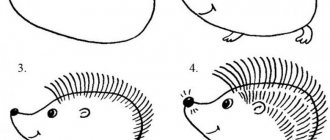Summary of the lesson on drawing with palms “Sun” (first junior group)
Elena Aleksandrovna Bizyaiva
Summary of the lesson on drawing with palms “Sun” (first junior group)
Municipal budgetary preschool educational institution kindergarten No. 62 of a combined type.
Summary of a lesson on drawing with palms
on the theme " Sunshine "
first junior group
Educator: Bizyayiva Elena Aleksandrovna
Sun ( painting with palms )
Purpose: to introduce the technique of palm . Learn to quickly apply paint to your palm and make an imprint - rays of the sun . Develop color perception.
Preliminary work: Learning nursery rhymes, observing while walking, playing games. Equipment: landscape paper with drawn in the middle, yellow gouache, brushes, napkins.
Project “Colored Palms”
Municipal preschool educational institution
"Lipitsa combined type kindergarten "Spikelet"
Project “Colored Palms”
(
use of unconventional drawing techniques)
1st junior group 2015-2016
Educator:
Polyakova N.A.
Relevance of the project:
Non-traditional drawing technique as a means of developing creative abilities in preschool children.
The world will be happy only when everyone
man will be the soul of an artist. In other words, when everyone finds joy in their work.”
Rodin
It is impossible to raise a creative person without beauty. Beauty is an eternal source of spirituality, inspiration, and creativity.
How to help a child discover himself most fully? How to create conditions for the dynamics of creative growth and support a child’s inquisitive desire to know the world in all its bright colors and manifestations? It is these questions that visual activity, one of the simplest, most exciting and accessible ways to develop a child, helps to solve.
In the field of artistic and aesthetic development of a child, the main objectives of educational activities are to create conditions for:
developing children's interest in the aesthetic side of reality.
introduction to various types of artistic and aesthetic activities,
developing the need for creative self-expression, initiative and independence in the embodiment of artistic ideas.
Using non-traditional drawing techniques helps us solve these problems with children of early preschool age, since at this age children have not yet developed the skills of drawing with a pencil and brush.
Such non-standard approaches to organizing visual activities surprise and delight children, thereby arousing the desire to engage in such an interesting activity. Original drawing reveals the child’s creative capabilities, allows you to feel the colors, their character and mood.
Non-traditional drawing techniques create an atmosphere of ease, openness, promote the development of initiative, independence, and create an emotionally favorable attitude towards activities in children.
That’s why we developed the “Colored Palms” project.
Objective of the project
— formation of artistic and creative abilities in children of early preschool age through non-traditional drawing techniques.
Tasks:
- develop children's imagination and creativity,
- enrich and expand the artistic experience of children,
- develop a desire to experiment,
- encourage and support creative ideas.
— to cultivate a child’s positive attitude towards cooperation with adults, with children, towards his own activities and its results.
Progress of the lesson:
1. A sunbeam and asks for help.
2. Children are ready to draw a lot of rays from the sun to make it lighter, warmer, and the snow to melt faster. Showing a method of applying gouache to the palm and imprinting it on paper.
4. Evaluation of work. Reading poems
“
Sunshine , sunshine ” Sunshine , sunshine , Look out the window, Shine a little light, I’ll give you some peas!
Olga Chusovitina “Me and the Sun ”
The sun is shining through my window in the morning, which means it’s time for me to go to kindergarten. I quickly wash my face, brush my teeth myself, and I can hear the cheerful noise of birds outside the window. The birds are happy that spring has come,
5. Games with a sun bunny .
Synopsis of the physical education lesson “Let's go on a flight” (first junior group) Synopsis of the physical education lesson 1st junior group. “Let's go flying.” Venue: on the street. Objectives: 1. Strengthen the ability to perform.
Summary of the integrated lesson “Grandfather Frost’s Birthday!” (first junior group) Summary of the integrated lesson “Grandfather Frost’s Birthday!” (1st junior group) Tasks: Introduce children to the main character of the New Year. Summary of the integrated lesson “Needles for a hedgehog” (first junior group) Integration of educational areas “Artistic and Aesthetic”, “Speech Development”, “Cognitive Development”, “Physical Culture”. Synopsis of the integrated lesson “Oh, the red rowan tree” (first junior group) Synopsis of the integrated lesson “Oh, the red rowan tree” (first junior group). Program content: Expand your understanding of trees.
Abstract of the educational activity for drawing "Balloons" (first junior group) (2-3 years) Abstract of the educational activity for visual activities (drawing) "Balloons" First junior group (2-3 years) Objectives:.
GCD summary for drawing “Let's decorate a plate” (first junior group) GCD summary for drawing “Let's decorate a plate.” (first junior group) Integration of educational areas: • cognition • socialization;.
Summary of the modeling lesson “Mother Duck and Ducklings” (first junior group) Purpose: To arouse in children the desire to depict, sculpt; Develop fine motor skills and creative abilities; Continue to master some. Summary of the lesson on plasticineography “Ladybug” (first junior group) Program content: • Form children’s ideas about the inhabitants of their immediate environment, teach them to recognize and name animals by their bright colors.
Source
Summary of a drawing lesson in the first junior group “Introduction to pencils”
— Guys, look at the colorful boxes I have. What do you think is in them? That's right, these are colored pencils.-I have drawings drawn with such pencils (the teacher shows different drawings and invites the children to find the drawn toys, flowers and other objects in the group)
- So, we got acquainted with pencils. But we need to draw our sun on something. What else do we need? Look around.
- Of course, it's paper. Look what she is like? That's right, white. But it is not only white (shows multi-colored paper).
- My friends, in order to make it easier for you to draw the sun, we will play with you.
Outdoor game "Sun"
Children hold hands and walk in a circle, at the command of the teacher, the children make the circle either narrower or wider.
- Guys, well done! And now we’ll try to touch the sun, do you think it’s possible to do this? What does the sun look like? That's right, on the ball. (the teacher gives each child a ball)
— Antosha, what color is your ball? (you can ask each child). Give your balls a good feel. What are they? Smooth, round. It’s as if you and I are holding the sun in our hands.
The sun looks out the window,
It shines into our room.
We will clap our hands -
We are very happy about the sun.
- Guys, now everyone will draw a sun for themselves. What color will we paint the sun? That's right, yellow. (the teacher shows how to hold a pencil correctly). Remember, kids, you can’t play around with pencils: throw them, poke them at someone, chew them or break them. First, let's try to draw the sun in the air. And now, on your pieces of paper (the teacher helps each child to correctly take a pencil and draw a circle, not forgetting to praise everyone’s attempts).
- Great, guys! But look, our sun is sleeping. To wake him up, we need to draw rays of light for him. Let's try to draw straight lines in the air. Great! Now let’s draw the rays of the sun. Great! (the teacher monitors the correctness of the children’s work techniques)
“We don’t put too much pressure on the pencil, otherwise the paper may tear and our sunshine will be ruined.”
- What wonderful drawings we made! When you've finished drawing, you need to clean up our assistants. Pencils should always be tidied up in boxes or cups, otherwise they may get lost and we will have nothing to draw bright and beautiful drawings with. Now you and I will hang our suns on our stand for drawings, they will delight us today, and in the evening you will take them home and show them to your dads and moms.
Notes on hand drawing in the first junior group "Bush"
IRINA GUSOVA
Notes on hand drawing in the first junior group "Bush"
Notes on GCD non-traditional drawing in the first junior group . " Bush "
Gusova Irina.
Goals and program objectives. Improve children's ability to draw with their palm , leaving an imprint on a sheet of paper and bring the drawing to perfection with the help of paints. Develop creative imagination. Cultivate a caring attitude towards the environment.
Handout and visual material. Sheets of light green or blue paper, brown and red paint, pictures depicting rowan bushes , lilacs, currants, etc. Preliminary work. Show the children several paintings of bushes . Progress. 1. The teacher draws the children’s attention to the pictures. “Children, what is shown in the picture? What bush ? (Children answer.)
2. Distribute paints, paper, and jars of water to the children.
3. Help each child to place their palm correctly on a sheet of paper . 4. Use red paint to complete the drawing. Finish drawing the berries .
5. Admire the finished image. Summary of GCD in the first junior group on non-traditional drawing “Healthy vitamins” Summary of GCD in the first junior group in non-traditional drawing (finger drawing). "HEALTHY VITAMINS." Malaeva N. M. teacher of the GBDOU d/s.
Abstract of the educational activity for drawing with potato stamps in the first junior group “Balloons” Municipal state preschool educational institution “Kindergarten No. 26”. Summary of direct educational activities. Notes on hand drawing "Tulips in a flower bed" Educational Department of the Istra City District Administration Notes on drawing lessons in the younger group using non-traditional.
Precautionary measures
Small children get tired quickly; for the first time it is enough to practice for no more than 5 minutes . Further, the child’s attention will not concentrate on creativity. The first few lessons are an adaptation period. You should not set difficult-to-achieve goals while you need to conduct lessons in the form of a game. While drawing, children, with the help of their parents, will be able to study geometric shapes, names of colors, various animals and types of transport, even body parts.
It is important to properly prepare the workplace and monitor the baby. First you need to deal with the paints. If it is watercolor, then it is diluted with water to a paste-like state. Thick gouache should also be made more liquid. Finger paints are ready to use. You can add glitter to them to make drawing more interesting.
It is better to pour the material into a flat saucer or plate. It is difficult for kids to get paint out of a small jar with their fingers; it is much easier to scoop it out of a large bowl. It is recommended to place a bowl of warm, clean water nearby. The child will wash his hands in it in order to continue using a different color. You also need to place a towel nearby, which can be stained with paint.
It is not advisable to leave your baby alone during classes. A small child can be so inventive that he will paint more than just paper . The role of parents during creativity is to channel the children's energy. The mother or father must communicate with the baby, prompt or help him. But you need to be allowed to make mistakes. Let a child draw crookedly or ugly - this is how he still expresses his “I”.
If the baby is not yet a year old, then it is better to provide him with a floor instead of a table. It is advisable to remove the carpet from it and lay down oilcloth. It is also recommended to remove all items that a child could damage. Wardrobes and beds can also be covered with oilcloth, otherwise they may be painted. If parents are afraid that the baby will freeze, you can put a warm blanket under him.
"Our palms." Summary of a lesson on drawing with palms in the first junior group
Victoria Dunaeva
"Our palms." Summary of a lesson on drawing with palms in the first junior group
Summary of a lesson on drawing with palms in the 1st junior group “ Our palms ”
• Develop creative imagination, attention, fine motor skills and hand coordination.
• Getting to know your hand as a subject of artistic activity.
• Develop small arm muscles.
• Reinforce the techniques of painting with gouache paints .
• Involve children and parents in the creative process, unite people of different ages.
• Attract children and adults to fine art using non-traditional techniques - “ palm drawing ”
Materials: Sheets of paper, yellow, green, blue and red finger gouache, brushes, wet wipes, pencils.
Materials and tools
All materials can be found in any store that sells office supplies. Children do not need professional expensive paints. It is better to choose those with a safe composition, because the child can taste them.
Required tools and materials:
- paper;
- finger or any other paints;
- dry and wet wipes;
- cotton swabs and disks;
- old toothbrushes;
- oilcloth or mat for creativity.
You can choose any paper for drawing - A4 or A3 sheets, Whatman paper, coloring books, colored cardboard. You don’t have to buy expensive goods; just buy a standard album or sketchbook. But the paper in them should be thick so as not to get wet from water. Suitable paints include watercolor, gouache, and special materials for fingers. They can be purchased at any art stores. The colors should be bright; there are watercolors and gouache with glitter. Such materials will interest children. You can draw figures not only with your hands - the child can use cotton pads or sticks, toothbrushes.
It is advisable to seat the baby at a comfortable table, and lay a blanket or pillow on the chair to make him comfortable. It is better to cover the workplace with oilcloth or a special rug. In any case, the children will cover it with paints. It is also recommended to dress the child in old clothes that you don’t mind getting dirty. And to cleanse the skin you need to use dry or wet wipes.
Kids won't be able to draw serious pictures yet.
Their first attempts will resemble meaningless scribbles: dashes, sticks, crooked lines, blots. But the more often the child practices, the more interesting his images will become. With age, technique will improve, and the most talented children will begin to create real masterpieces.
Progress of the lesson
- Today you and I will be wizards, not with a brush , but with our palms, together with our mothers .
-Let's all roll up our sleeves together, take the sponges and dip them in the paint, then apply the paint to your palm , place your palm on the leaf and remove it , you get a palm . Look, your palm is dirty , what should you do?
- Yes, it’s good to wipe with a wet napkin.
Let's practice with you, as if the paint is standing next to us
— Dip your palm in paint and apply it to a sheet of paper. Let's try again (2nd time)
dip in paint and apply.
— When you finish, wipe your palms with napkins .
- Oh, what fun spring palms we got ! Let's admire them!
Now we need to figure out what can come out of our palms ? Let's try to paint on the details with our fingers . What a beauty we have, octopuses, cockerels, elephants, and very beautiful spring flowers.
- Well done boys! Well done! Many thanks to our mothers !
Now let's go wash our hands so they are clean.
Artistic and creative project “I’m not a wizard, I’m just learning!” “I’m not a wizard, I’m just learning” Artistic and creative project. II – junior group. Educator: Petrenko A.I. Relevance: Fine.
Source
Drawing lesson: “Cheerful palms”
Objectives: to introduce children to an unconventional drawing technique (palm); learn how to independently come up with the composition of a drawing; develop creative imagination, attention, fine motor skills and hand coordination.
Equipment: simple pencil; set of gouache paints; brushes; palette; jars of water; napkins.
Progress:
Teacher: Today I offer you a new way of drawing. You've never drawn like this before. We will trace the palms and come up with interesting designs from them. (Then the lesson is conducted with a demonstration of drawing diagrams.)
Baby dinosaur Smiles sleepily: Mom is nearby, dad is nearby - What else is needed for happiness?
Take a closer look: It's a cactus. It's prickly. And when the rains come, all the thorns will bloom.
The elephant gave flowers to the baby elephant, and then said in his ear: “You eat better, my glorious son, so that you can grow up strong, like your dad.”
How many stars are there in the sky? I wish I could get at least one, If you can’t get even one, We’ll bark at the moon.
There is a stump in the clearing, It is not low, not high. Look, guys, what's growing on it? Honey mushrooms!
The octopus dad couldn't catch up with his son for an hour. The octopus barely calmed down a little, Because he needs to sleep, The legs need to rest.
A seahorse rushes quickly, as fast as he can. Under water. Here I am stuck in the thick grass, I shout: “Gotcha, stop!”
Together with my friend, we draw a riddle, Palm, press the other one in order. Let's add circles, decorate them again - And now our butterfly is ready.
A scarlet flower has blossomed in the thicket, Each petal shines like a firebird. This is such a miracle. On my sheet of paper a fairy tale comes to life in complete darkness.
Teacher: - Do you want to try? Take a close look at your hands. Place your palm on a piece of paper. Turn it, move it. - Look! Imagine! Let your imagination run wild! Our palms can turn into whoever we want! Did you come up with it? Then press your palm and trace with a simple pencil. - And then fill in the missing details. - Well, now you can color your drawing using pencils, crayons or paints.
Teacher:
Guys, we are a little tired, let's take a rest: We painted today, Our fingers are tired. Let's shake our fingers and start drawing again.
Teacher: Well done, guys! Look, we tried our best, and we came up with beautiful drawings. Guys, did you like turning your palm? (Children's answers). Today we will arrange an exhibition so that parents can also admire your work.
Here is the exhibition of “funny palms” we got:
Summary of GCD for drawing with palms in the first junior group “Birds”
Nadezhda Stupnikova
Summary of GCD for drawing with palms in the first junior group “Birds”
Summary of the drawing lesson “ Birds ”
in 1st
junior group .
Goal: to develop the skill of drawing with palms . Refine and consolidate knowledge of colors. Develop interests and a positive attitude towards drawing . Develop household skills.
2. Develop memory, imagination, logical thinking,
creative abilities: sense of color, imagination.
Materials for the lesson:
For the teacher: Illustration with a picture of a bird , album sheet,
gouache, brush, napkin, bowl of water.
For children: Landscape sheet, gouache, brushes No. 6 and No. 3, napkins.
Handprint Crafts
Children at the age of 1 do not yet know how to draw, sculpt or carve. Their acquaintance with decorative and applied arts is just beginning. All that children can do at this age with their own hands and, of course, with the help of adults, is crafts from handprints.
For creativity, mothers stock up on gouache and watercolor paints and sketchbooks.
The most understandable topic for a child aged 1–2 years is the animal world, birds, fish.
Craft ideas
Creative activities with children are carried out in a playful way. And ideas for crafts from children's palms are found in books. Colorful illustrations for fairy tales and poems help with this.
When adults know what story to interest the child, it’s time to cover the table with oilcloth and pour paint into flat plates.
By turning children's hands in different ways and painting on the missing elements to the handprints, mothers embody ideas. And the kids at this time express delight and joy.
In the first lessons, use one color of gouache or watercolor paint. Children are shown how to paint pens and then press them onto paper. When they get the hang of it, you can create crafts from multi-colored palms, smearing each finger with the desired colors.
Crafts chest
| Prints on paper | Craft | What to finish drawing for mom |
| Closed fingers | Fish in an aquarium | Eye, fins, tail |
| Berry | Leaf, dots | |
| Spread fingers looking down | Octopus | Mouth and eyes |
| Flower | Stem, leaves | |
| Elephant | Tail, eye, mouth, ear |
| The thumb is the neck, and the rest are the tail. | Hen | Beak, scallop, two legs |
| 4–6 palms in a circle | Sun | Middle |
| Sunflower | Stem, leaves, seeds | |
| 2–4 palms fanned out | Hedgehog | Muzzle, paws, eyes |
| 4–6 palms in a row with fingers pointing down | Caterpillar | Head with horns, eyes |
| Two palms on both sides | Butterfly | Body, antennae |
Progress of the lesson.
Organizational moment: children stand in a circle.
Educator: Guys, show your palms , stroke them, clap your hands , close your eyes with your palms , rub your cheeks with your palms . palms can do . also draw birds with your palms . (Children sit at tables.)
Educator: Guys, why did the birds fly away ?
Children: It’s getting cold, the birds have nothing to eat .
Educator: Well done, guys! Guess the riddles about what birds they are talking about!
He steals hemp. (sparrow)
Blue scarf, dark back.
Little bird , call her. (titmouse)
Children: These birds are wintering birds.
Educator: Well done! Let's draw a bird . Before drawing we must do finger exercises.
on your palm ,
Feeding the cute titmouse
The bird pecks the grains,
Sings songs to children:
I fly all day.
Educator: Look at my palm , it seems to me that it looks very much like a bird. And what do you think? Where is the bird's beak? Where's the neck? Show the body of the bird. What a wonderful fluffy tail. (The teacher shows on his palm , the children on theirs).
